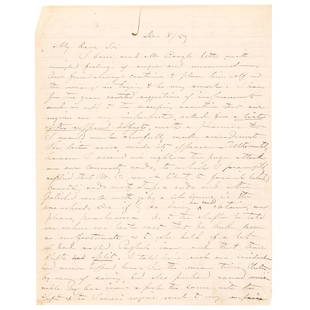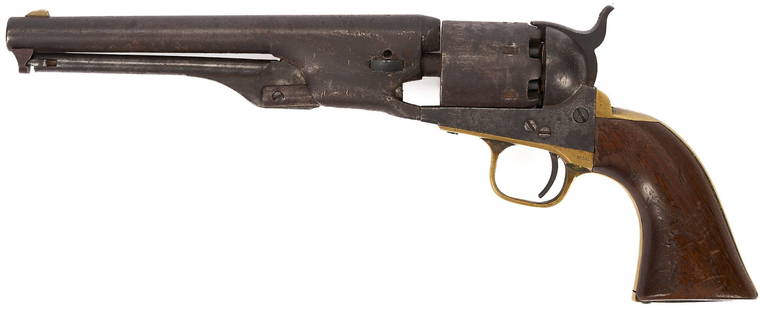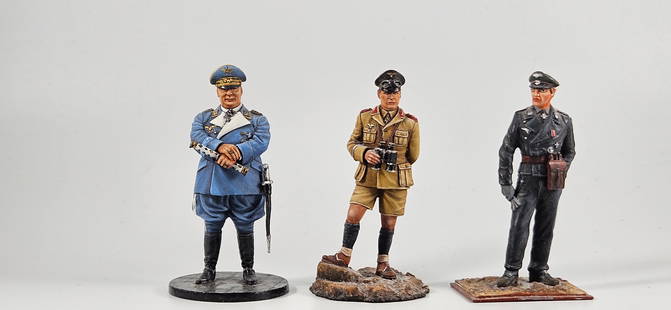
JOHN ERICSSON Autographed Letter Signed, Builder of the Civil War Union Ironclad Monitor
Similar Sale History
View More Items in Militaria & War Memorabilia
Related Militaria & War Memorabilia
More Items in Militaria & War Memorabilia
View MoreRecommended Collectibles
View More




Item Details
Description
Autographs
1862 Autograph Letter Signed by John Ericsson Builder of the Historic Civil War Union Ironclad Ships & "Monitor"
JOHN ERICSSON (1803-1889). Built the Civil War Union's Ironclad Ship "Monitor" the first screw propeller-powered vessel and made improvements in locomotives, c. 1829; Swedish-American Engineer and Designer.
October 13, 1862-Dated, Civil War Period, Autograph Letter Signed "J Ericsson", 1 page, measuring about 7.75" x 9.75", at New York, Choice Very Fine. This Civil War date Letter written to, "Messrs. Lazell, Perkins & Co." in Bridgewater (Mass.), regarding Ericsson's personal engineering specifications. By 1860, at the dawn of the Civil War, the Bridgewater Iron Company was one of the largest in the country, specializing in heavy castings and forgings, including key parts for the United States Navy, including the famous USS Monitor and the USS New Ironsides iron-clad warships. By 1868, the company employed about 600 men. This historic "Ironclad" U.S. (Union) Navy related construction letter reading:
"I herewith enclose you working drawings of Main Crank and Crank pin for the 'Dictator' and 'Puritan' and propeller Shaft of the 'Dictator'. -- I wish you to do all the work except shrinking the main Crank and fitting the Pin. -- Yours truly, (Signed) J Ericsson".
Docket on the blank reverse reads: "J. Ericsson / Oct. 13th 1862".
The "USS Puritan" and the "USS Dictator" were the two Ocean-going Monitors designed by Ericsson. Due to delays, the Puritan was never completed. The USS Dictator served in the North Atlantic Blockading Squadron and the North Atlantic Fleet, and was ultimately decommissioned on June 1, 1877.
Provenance: Collection of Ambassador J. William Middendorf II.
USS Puritan was one of two ocean-going ironclad monitors designed by John Ericsson during the American Civil War of 1861"1865. Launched in mid-1864, construction was suspended sometime in 1865. The Navy Department had specified two twin-gun turrets over Ericsson's protests, but finally agreed to delete the second turret in late 1865. The Navy Department evaded the Congressional refusal to order new ships in 1874 by claiming that the Civil War-era ship was being repaired while building a new monitor of the same name.
Puritan was 340 feet (103.6 m) long overall, had a beam of 50 feet (15.2 m) and had a draft of 20 feet (6.1 m). The ship had a tonnage of 3,265 tons burthen and displaced 4,912 long tons (4,991 t). She was powered by a two-cylinder vibrating-lever steam engine with a bore of 100 in (2.5 m) and a stroke of 48 in (1.2 m). The engine drove two propeller shafts using steam provided by six Martin water-tube boilers and the designed speed was 15 knots (28 km/h; 17 mph). Puritan was designed to carry a maximum of 1,000 long tons (1,016 t) of coal.
The monitor was originally intended to mount two twin-gun turrets, but Ericsson persuaded the Navy Department to switch to a single turret armed with a pair of 20-inch (508 mm) smoothbore, muzzle-loading, Dahlgren guns. None of the guns were completed before the end of the war. Puritan's armor scheme was identical to that of Dictator, the other ocean-going monitor ordered at the same time. Her hull was protected by six layers of 1-inch (25 mm) wrought-iron plates and her ship's deck armor was 1.5 in (38 mm) thick. The armor of the gun turret had a total thickness of 15 in (381 mm) and consisted of six outer layers, blocks of 4.5-inch (114 mm) segmented armor slabs in the middle and then four more layers. The pilot house armor was 12 in (305 mm) in thickness.
Buoyed by the victory gained by Ericsson's Monitor during the Battle of Hampton Roads in early March 1862, the Navy Department decided later that month to build several ocean-going monitors in case the British or the French decided to intervene in the war. Ericsson submitted preliminary designs in May and Secretary of the Navy Gideon Welles authorized two ships, one with a single turret (Dictator) and a larger one with two turrets (Puritan) the following month.
On 28 July the Navy Department awarded Ericsson with a contract for Puritan, having changed the name of the ship from Ericsson's submission of Protector. He subcontracted the hull of the Puritan to the Continental Iron Works of Greenpoint, Brooklyn, and the propulsion machinery to the Allaire Iron Works of New York City. The ship was laid down in 1863 and was launched on 2 July 1864.
However, due to delays in building and the casting of the 20-inch smoothbores, her construction was suspended in 1865 and she was never completed.
After the war, Puritan deteriorated on the stocks and she was sold to John Roach in 1874. Although Congress was informed by the Navy Department that the Civil War-era ship was being repaired, a new iron-hulled monitor of the same name was built with repair money and the proceeds of her sale because Congress refused to fund any new construction at this time.
The Bridgewater Iron Works is a historic industrial site located on High Street in Bridgewater, Massachusetts, United States, along the banks of the Town River. Previously known as Lazell, Perkins and Company, by the mid-19th century, the Bridgewater Iron Manufacturing Company was one of the largest iron works in the United States, specializing in heavy castings and forgings. The property was later acquired by the Stanley Works, with the surrounding village still known to this day as Stanley.
The location was most recently used for manufacturing by the Bridgewater Foundry Company until 1988. It has since been converted into a small public park, with only the remnants of a stone storehouse remaining. The site was added to the National Register of Historic Places in 2002.
1862 Autograph Letter Signed by John Ericsson Builder of the Historic Civil War Union Ironclad Ships & "Monitor"
JOHN ERICSSON (1803-1889). Built the Civil War Union's Ironclad Ship "Monitor" the first screw propeller-powered vessel and made improvements in locomotives, c. 1829; Swedish-American Engineer and Designer.
October 13, 1862-Dated, Civil War Period, Autograph Letter Signed "J Ericsson", 1 page, measuring about 7.75" x 9.75", at New York, Choice Very Fine. This Civil War date Letter written to, "Messrs. Lazell, Perkins & Co." in Bridgewater (Mass.), regarding Ericsson's personal engineering specifications. By 1860, at the dawn of the Civil War, the Bridgewater Iron Company was one of the largest in the country, specializing in heavy castings and forgings, including key parts for the United States Navy, including the famous USS Monitor and the USS New Ironsides iron-clad warships. By 1868, the company employed about 600 men. This historic "Ironclad" U.S. (Union) Navy related construction letter reading:
"I herewith enclose you working drawings of Main Crank and Crank pin for the 'Dictator' and 'Puritan' and propeller Shaft of the 'Dictator'. -- I wish you to do all the work except shrinking the main Crank and fitting the Pin. -- Yours truly, (Signed) J Ericsson".
Docket on the blank reverse reads: "J. Ericsson / Oct. 13th 1862".
The "USS Puritan" and the "USS Dictator" were the two Ocean-going Monitors designed by Ericsson. Due to delays, the Puritan was never completed. The USS Dictator served in the North Atlantic Blockading Squadron and the North Atlantic Fleet, and was ultimately decommissioned on June 1, 1877.
Provenance: Collection of Ambassador J. William Middendorf II.
USS Puritan was one of two ocean-going ironclad monitors designed by John Ericsson during the American Civil War of 1861"1865. Launched in mid-1864, construction was suspended sometime in 1865. The Navy Department had specified two twin-gun turrets over Ericsson's protests, but finally agreed to delete the second turret in late 1865. The Navy Department evaded the Congressional refusal to order new ships in 1874 by claiming that the Civil War-era ship was being repaired while building a new monitor of the same name.
Puritan was 340 feet (103.6 m) long overall, had a beam of 50 feet (15.2 m) and had a draft of 20 feet (6.1 m). The ship had a tonnage of 3,265 tons burthen and displaced 4,912 long tons (4,991 t). She was powered by a two-cylinder vibrating-lever steam engine with a bore of 100 in (2.5 m) and a stroke of 48 in (1.2 m). The engine drove two propeller shafts using steam provided by six Martin water-tube boilers and the designed speed was 15 knots (28 km/h; 17 mph). Puritan was designed to carry a maximum of 1,000 long tons (1,016 t) of coal.
The monitor was originally intended to mount two twin-gun turrets, but Ericsson persuaded the Navy Department to switch to a single turret armed with a pair of 20-inch (508 mm) smoothbore, muzzle-loading, Dahlgren guns. None of the guns were completed before the end of the war. Puritan's armor scheme was identical to that of Dictator, the other ocean-going monitor ordered at the same time. Her hull was protected by six layers of 1-inch (25 mm) wrought-iron plates and her ship's deck armor was 1.5 in (38 mm) thick. The armor of the gun turret had a total thickness of 15 in (381 mm) and consisted of six outer layers, blocks of 4.5-inch (114 mm) segmented armor slabs in the middle and then four more layers. The pilot house armor was 12 in (305 mm) in thickness.
Buoyed by the victory gained by Ericsson's Monitor during the Battle of Hampton Roads in early March 1862, the Navy Department decided later that month to build several ocean-going monitors in case the British or the French decided to intervene in the war. Ericsson submitted preliminary designs in May and Secretary of the Navy Gideon Welles authorized two ships, one with a single turret (Dictator) and a larger one with two turrets (Puritan) the following month.
On 28 July the Navy Department awarded Ericsson with a contract for Puritan, having changed the name of the ship from Ericsson's submission of Protector. He subcontracted the hull of the Puritan to the Continental Iron Works of Greenpoint, Brooklyn, and the propulsion machinery to the Allaire Iron Works of New York City. The ship was laid down in 1863 and was launched on 2 July 1864.
However, due to delays in building and the casting of the 20-inch smoothbores, her construction was suspended in 1865 and she was never completed.
After the war, Puritan deteriorated on the stocks and she was sold to John Roach in 1874. Although Congress was informed by the Navy Department that the Civil War-era ship was being repaired, a new iron-hulled monitor of the same name was built with repair money and the proceeds of her sale because Congress refused to fund any new construction at this time.
The Bridgewater Iron Works is a historic industrial site located on High Street in Bridgewater, Massachusetts, United States, along the banks of the Town River. Previously known as Lazell, Perkins and Company, by the mid-19th century, the Bridgewater Iron Manufacturing Company was one of the largest iron works in the United States, specializing in heavy castings and forgings. The property was later acquired by the Stanley Works, with the surrounding village still known to this day as Stanley.
The location was most recently used for manufacturing by the Bridgewater Foundry Company until 1988. It has since been converted into a small public park, with only the remnants of a stone storehouse remaining. The site was added to the National Register of Historic Places in 2002.
Buyer's Premium
- 30%
JOHN ERICSSON Autographed Letter Signed, Builder of the Civil War Union Ironclad Monitor
Estimate $800 - $1,200
1 bidder is watching this item.
Shipping & Pickup Options
Item located in Rancho Santa Fe, CA, usOffers In-House Shipping
Payment

Related Searches
TOP





















![[CIVIL WAR]. EARLY, Jubal A. (1816-1894). Two post-war autographed letters signed ("JA Early") to: [CIVIL WAR]. EARLY, Jubal A. (1816-1894). Two post-war autographed letters signed ("JA Early") to Reverend James Powell Smith. Lynchburg, VA, 2 and 16 May 1887. Each 2 pages, 8vo, on Morris blin](https://p1.liveauctioneers.com/197/250551/130130025_1_x.jpg?height=310&quality=70&version=1654185975)






![[CIVIL WAR - NAVY]. A group of 2 letters relating to the Kearsarge and Alabama, comprising:: [CIVIL WAR - NAVY]. A group of 2 letters relating to the Kearsarge and Alabama, comprising: Autograph letter signed ("A") to Mr. [John McIntosh Kell]. Wheeling, WV, 13 February 1866. The integral addr](https://p1.liveauctioneers.com/197/250551/130130039_1_x.jpg?height=310&quality=70&version=1654185975)

















































